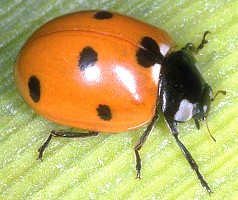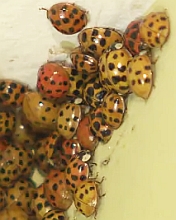  Ladybugs, which are really beetles, live all over North America, as well as in many other places on earth. In fact, there are over 3000 different species of ladybug! Many are orange, light yellow, or red in colour, and most have black spots on their wing covers.
Ladybugs, which are really beetles, live all over North America, as well as in many other places on earth. In fact, there are over 3000 different species of ladybug! Many are orange, light yellow, or red in colour, and most have black spots on their wing covers.Like many brightly coloured insects, the ladybug has a bad taste, and is avoided by most predators. When it is disturbed, it releases a bad-smelling fluid from its joints to warn predators that it is not good to eat. Ladybugs are harmless to humans, although they may nibble your finger if you pick one up. They are beneficial in your garden, because they eat other insect pests ... one ladybug can eat as many as 30 to 60 per day! Not all ladybugs are really ladies. There are male ladybugs too! The female ladybug lays tiny eggs in plants in the spring, often near aphid colonies, which are the ladybug's favourite food. Females lay from 300 to 1,500 eggs during their lifetime. After a few days the eggs hatch. The larvae are all born black, and it takes them only about a week to grow into an adult ladybug. Adult ladybugs can survive the winter, staying warm under piles of dead leaves and other litter. The 7-spotted ladybug is one of the most common ladybugs. Gardeners love them because, like all ladybugs, they eat a lot of insects that hurt gardens and crops. They will eat aphids, mealybugs, spider mites and the eggs of other insects. Another variety is the Asian lady beetle, whose colour varies from yellowish-orange to red, with deep orange being the most common color. There are 19 black spots on the back; the spots may be faint or missing on some beetles. There is a black 'W'-shaped mark on the thorax.
Other types of lady beetle include the following varieties:  In recent years, multicoloured Asian ladybeetles have invaded Eastern Canada. The beetle is not native to Canada, and was introduced to North America to help control aphid populations. In a matter of a decade its populations exploded.
Scientists say the beetles are looking for a place to overwinter. The nonnative species bites and can secrete a smelly orange liquid if handled, but they are not dangerous. When handled, the beetles fold their limbs and do something called "reflex bleeding" which involves exuding a substance from the leg joints containing chemical compounds that are very distasteful. Predators of lady beetles, when they eat the beetle, get that in their mouth and presumably spit the beetle out and then remember, 'don't eat bright coloured beetles that have black spots'."
In recent years, multicoloured Asian ladybeetles have invaded Eastern Canada. The beetle is not native to Canada, and was introduced to North America to help control aphid populations. In a matter of a decade its populations exploded.
Scientists say the beetles are looking for a place to overwinter. The nonnative species bites and can secrete a smelly orange liquid if handled, but they are not dangerous. When handled, the beetles fold their limbs and do something called "reflex bleeding" which involves exuding a substance from the leg joints containing chemical compounds that are very distasteful. Predators of lady beetles, when they eat the beetle, get that in their mouth and presumably spit the beetle out and then remember, 'don't eat bright coloured beetles that have black spots'."
|
